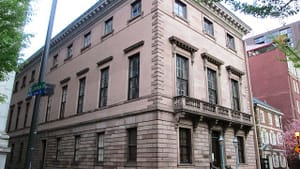Stay in the Loop
BSR publishes on a weekly schedule, with an email newsletter every Wednesday and Thursday morning. There’s no paywall, and subscribing is always free.
A library pilgrimage
Athenaeums of the Northeast

Back in 2008, after surviving a broken heart, I went on a search for private clubs to join in the city of Philadelphia. I wanted a second home that was not a bar, gym, coffee shop, public entity, yoga studio, or any semblance of my workplace. My eventual choice was the Athenaeum of Philadelphia, a membership library housed in a stately sandstone building of the Italianate Revival style on the east side of Washington Square.
It’s been a haven. The Philadelphia Athenaeum, currently celebrating 200 years of operation, houses a full-complement lending library in addition to its mission of conserving books, prints, photographs, and rarities related to architecture and interior design. There are gorgeously embellished and prettily pastel-colored reading rooms upstairs and a sedate exhibition gallery at street level. Various days throughout the month, members and guests may attend cultural events. Upcoming on Friday, September 12, for example, is a free-to-all lecture by the founding director of the Center for Architecture, Design and Engineering at the Library of Congress entitled Curator’s Choice: Favorites from Forty Years of Collecting for the Nation. And to mark the bicentennial, the Athenaeum will, on the same day, open an exhibit entitled Treasures of the Athenaeum, recognizing its 200-year history of collecting.
Before the existence of tax-supported public libraries, member-supported private libraries were common throughout the United States. The Philadelphia Athenaeum is one such library, in a surviving group of 18 (stretching from Portland, Maine to La Jolla, California) that continue to thrive in architecturally significant buildings holding special collections. A year ago, I determined to visit all 18.
Last year took me to the Athenaeum of St. Johnsbury, Vermont, founded in 1871. Though still a private nonprofit corporation, the St. Johnsbury also serves as the town’s only public library. The abundant interior woodwork of the French Second Empire building with a mansard roof is marvelous, including carved spiral staircases. There is an unchanging 19th-century art gallery, a real period place, with a generous display of American landscapes, heavily framed. The centerpiece, and an attraction for visitors worldwide, is Albert Bierstadt’s 10’x15’ canvas, The Domes of the Yosemite — magnificent! Visitors may enjoy a docent-guided tour.
On the road
This month, on my way home from Nova Scotia, I took in the range of private libraries dotting the coast of New England: Portland, Maine (1815); Portsmouth, New Hampshire (1817); Salem, Massachusetts (1810); Boston, Massachusetts (1807); Providence, Rhode Island (1836); Newport, Rhode Island (1747); and New Haven, Connecticut (1826). What a wonderful way to see the coastal cities!
One enters the largest and grandest of the private libraries, the hallowed Boston Athenaeum in the Beacon Hill neighborhood, through impeccable red leather doors, gold studded. One comes upon a glorious white vaulted interior. Everything visible by way of design — including furniture, fabric, decoration, cornices, banisters, marble pedestals, and sculpted book casings — is altogether outstanding. Artworks abound, comprising portraits, landscapes, cityscapes, and still lifes. Each library and gallery room, one after another, feels beautiful and quiet, not tomblike in the least but spacious, a sanctuary free of chatter. People are reading, studying, writing, ruminating, and gazing at greenery through floor-to-ceiling windows. In earlier days, writers Emerson, Hawthorne, and Thoreau were members here, along with poet Amy Lowell and premier feminist Margaret Fuller. A favored quote and presumed aspiration of the Boston Athenaeum derives from author Jorge Luis Borges: “I have always imagined that paradise will be a kind of library.” On Beacon Hill, there is evidence that a library will be a kind of paradise.
The birth of the Classical
The oldest of the 18 private libraries, birthed 29 years before the birth of the United States of America, is the Redwood Library and Athenaeum located in the museum area of Newport, Rhode Island. I’d never stopped in Newport, never took time to appreciate the remarkable American architecture and dramatic situation of this city plummeting from cliffs to the sea, a city that once competed with New York for port priority and lost.
The Redwood building marks the first representation of Classical style in a public building in the new world of the American colonies. Designed in the manner of a Greek or Roman temple with Doric columns, portico, and wings (by the first professionally trained American architect, Peter Harrison), it offers a gracious, studious, restful visage. Today, the library enjoys perfect placement in a lawn and garden setting. A life-size George Washington, reproduced in bronze from a cast of the famous 18th-century marble sculpture by Jean-Antoine Houdon, commands the library’s entrance. (Another bronze replication of the same Houdon sculpture honors the tomb of the Unknown Soldier on Washington Square in Philadelphia. From his west side vantage, Washington gazes eastward across the square upon the Athenaeum of Philadelphia.)
I have been thinking that the sculpture of Washington outside the Redwood may be well accompanied by one of Thomas Jefferson. As told to me by a Redwood librarian, the story goes that when Jefferson, looking up from a boat in the Newport harbor, spied the library building high on a hill, he declared that they of the republic should model their to-be-built national edifices on this new architectural style, known as Classical. The sailing companion with whom Jefferson shared his declaration was President George Washington.
The Redwood Library and Athenaeum specializes in collecting literary and historical books and materials of merit. As in Boston, wonderful writers were once members in Newport: Edith Wharton, Henry James, Henry Wadsworth Longfellow, and Julia Ward Howe; as well as painter Gilbert Stuart. The Redwood also functions as a museum. I was able to contemplate several canvases painted by Gilbert Stuart, including a self-portrait. His unfinished portrait of George Washington — the face seen for over a century on the one-dollar bill, and, oddly enough, entitled The Athenaeum — is not at the Redwood. But there is at the Redwood a copy of Stuart’s celebrated “Lansdowne portrait” of Washington refusing a third term as president. Stuart’s daughter Jane painted the Redwood copy. (You may recall that a copy painted by Stuart himself hangs in the Pennsylvania Academy of Fine Arts.) Looking at the daughter’s copy at the Redwood, one can experience the difference that makes a masterpiece: The daughter’s version is skillful, whereas one remembers the father’s as alive.
And the Redwood operates an art gallery. I browsed the current exhibit, Portraits of Interiors, displaying artistic portrayals in color of notable interior spaces, empty of occupants — drawing rooms, ballrooms, entrance halls, and salon or music rooms without people in them. But the presence and taste of persons who would occupy the room are suggested through the artist’s depiction of a rumpled cushion or sheaf of papers. Here was a genre new to me that apparently began in the 19th century with the work of interior illustrators. According to the exhibit curator, “The paintings stand as a record of worldly possessions and architecture” — delightfully fitting to the tradition of wealth, opulence, and luxury characterizing Newport.
It tasted bittersweet on a brilliant summer afternoon to depart the skies and waters of Newport for the interstates, turnpikes, highways, and roads from Rhode Island to Connecticut to New York to New Jersey to Pennsylvania to my house. Decidedly, joining Philadelphia’s Athenaeum (deriving from "Athena,” the Greek goddess of wisdom) was a wise choice, as a second home to come home to.
Above right: Houdon's statue of George Washington. This photo is of the one at the North Carolina State Capitol. (Photo by Daderot, via Creative Commons/Wikimedia)
Sign up for our newsletter
All of the week's new articles, all in one place. Sign up for the free weekly BSR newsletters, and don't miss a conversation.

 Joanna Rotté
Joanna Rotté